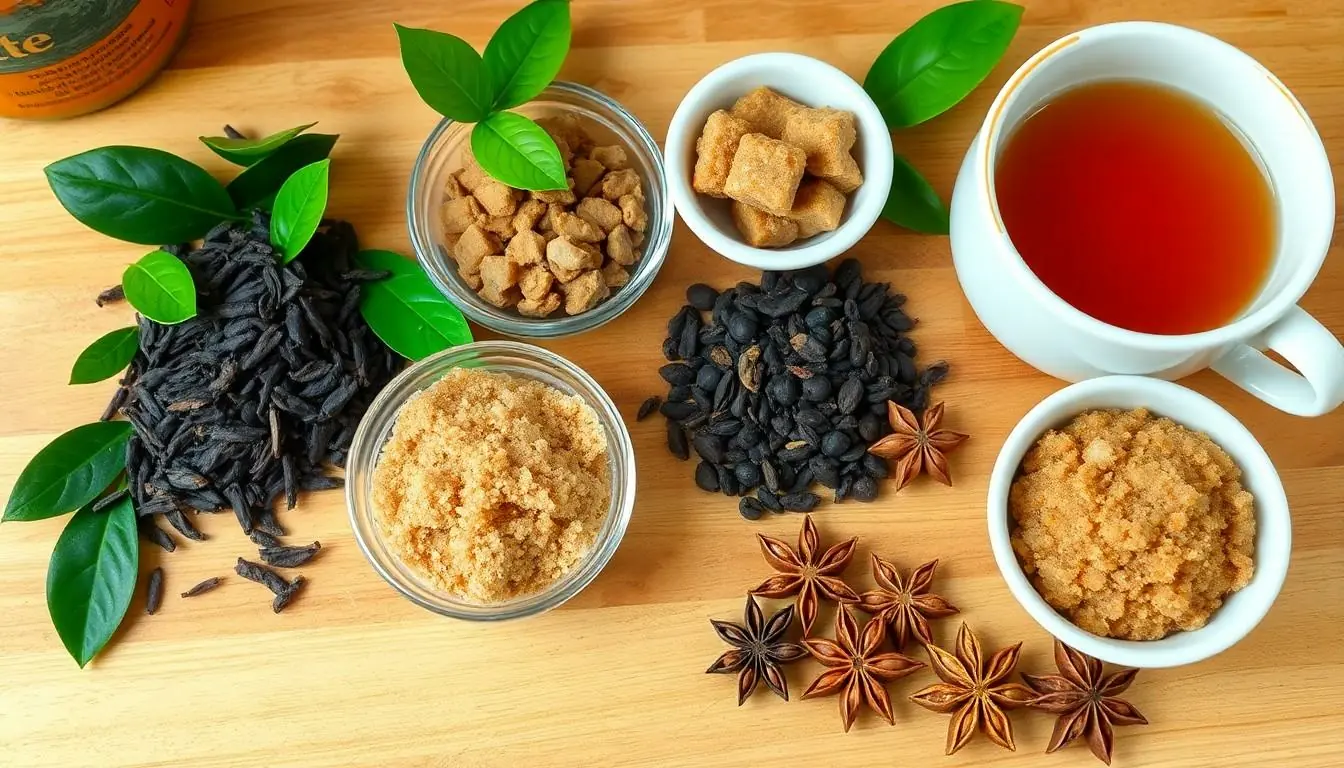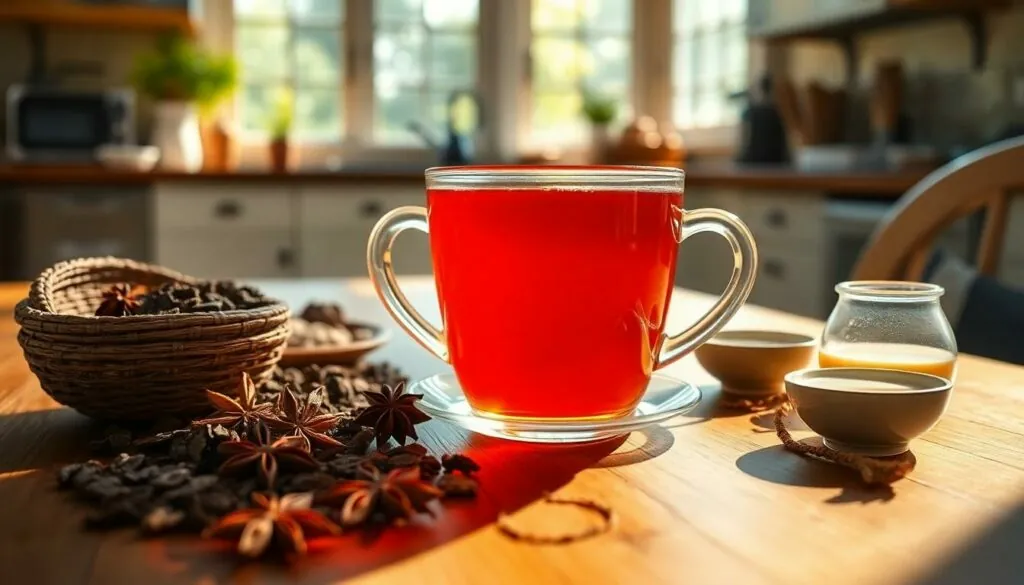Table of Contents
ToggleImagine sipping a creamy cup of Thai tea, its rich flavors dancing on your taste buds while you lounge in your favorite chair. Sounds dreamy, right? Well, you don’t have to book a flight to Thailand to indulge in this delightful beverage. Making Thai tea at home is easier than convincing a cat to ignore a laser pointer.
What Is Thai Tea?
Thai tea is a traditional beverage originating from Thailand, known for its distinct flavor and vibrant color. This drink features a blend of black tea, spices, and condensed milk, creating a sweet and creamy experience. Often served iced, Thai tea has become popular in many parts of the world, especially in Asian restaurants.
The primary ingredient, Ceylon tea, contributes a robust flavor, while additional spices like star anise and cardamom enhance its aroma. The deep orange hue comes from food coloring, which is commonly added to achieve its signature look. In Thailand, vendors commonly prepare this drink by brewing the tea leaves in boiling water, allowing the flavors to develop fully.
Condensed milk plays a crucial role in Thai tea, adding sweetness and creaminess. Some recipes incorporate evaporated milk for a lighter texture or coconut milk for a vegan alternative. Traditionally, sugar is added to enhance taste, making Thai tea a delightful treat for sweet lovers.
Beyond its taste, Thai tea offers potential health benefits. Black tea contains antioxidants, which may support overall health. Its spiced profile can aid in digestion, making it a comforting choice after a meal. As a popular drink, Thai tea reflects the rich culinary traditions of Thailand, inviting many to enjoy its unique flavors from home.
Ingredients Needed

Making Thai tea requires a few essential ingredients. It’s important to select high-quality components to achieve that authentic flavor.
Tea Types
Ceylon black tea serves as the primary base. It provides a bold flavor that complements the drink. Assam tea can also work well, offering a similar richness. Some people prefer to blend different tea types for a unique taste. For those seeking variety, consider using Thai tea blends that include spices for added depth.
Sweeteners
Condensed milk offers the traditional sweetness and creaminess, enhancing the overall flavor profile. Brown sugar can act as an alternative, adding a richer taste. Honey presents another option, providing a natural sweetness. For a dairy-free choice, agave syrup works well. Each sweetener contributes differently, so experimenting may yield a preferred option.
Additional Flavorings
Cardamom and star anise add aromatic notes that elevate the tea’s complexity. Vanilla extract can enhance the sweetness and bring out the tea’s unique character. Some recipes call for orange blossom water, adding a floral hint. Other spices, like cinnamon, introduce warmth, offering a delightful twist. Each flavoring option can create a personalized version of this beloved drink.
Step-by-Step Guide
Creating a flavorful cup of Thai tea at home involves a few simple steps. Follow this guide to craft an authentic and delightful beverage.
Brewing the Tea
Start by boiling water in a pot, using about four cups for a strong brew. Once the water reaches a rolling boil, add four tablespoons of Ceylon black tea or Assam tea for richness. Incorporate spices such as two star anise and two crushed cardamom pods for added aroma. Allow the tea mixture to steep for five to seven minutes, ensuring it achieves a deep orange hue. Adjust the steeping time based on personal preference for strength.
Straining the Mixture
After steeping, it’s time to strain the tea mixture. Use a fine mesh strainer or cheesecloth to separate the liquid from the tea leaves and spices. Position the strainer over a heatproof pitcher and pour the brewed tea through it. This step removes any solids, leading to a smooth beverage. Discard the used tea leaves and spices immediately for ease.
Adding Milk and Sweetener
To enhance the flavor, add half a cup of sweetened condensed milk to the strained tea. Consider alternatives such as evaporated milk or coconut milk for a different texture. Stir in the milk until well incorporated, creating a creamier drink. Sweeteners like brown sugar, honey, or agave syrup can be adjusted to taste. Aim for a balance that complements the tea’s robust flavor. Serve the Thai tea over ice for a refreshing experience.
Tips for Perfecting Thai Tea
Perfecting Thai tea at home involves mastering flavor and presentation. Tweaking ingredients can lead to a truly enjoyable experience.
Adjusting Flavor
Experimenting with ingredients allows customization of Thai tea’s flavor. Use Ceylon or Assam tea as the base, balancing bitterness with sweeteners like sugar or honey. Incorporate spices such as star anise or cardamom to enhance aroma and complexity. Adding a splash of vanilla extract creates a richer flavor profile. Adjust the amount of condensed milk for desired creaminess, accommodating personal taste preferences. Substituting coconut milk provides a different texture while infusing exotic notes. Taste-testing during preparation ensures the beverage meets individual expectations. Using food coloring can amplify the tea’s vibrant hue, adding visual appeal to the final presentation.
Serving Suggestions
Serving Thai tea can elevate the overall experience. Serve the tea over ice for a refreshing twist, especially on warm days. Garnishing with a fresh mint leaf adds a touch of color and enhances aroma. Consider using clear glassware to showcase the drink’s vibrant orange hue. Pairing Thai tea with desserts like mango sticky rice or coconut pudding complements its flavors well. Serving in traditional Thai cups or with decorative straws offers an authentic touch. Providing a range of sweeteners on the side accommodates diverse taste preferences, enhancing guest interaction. Each serving can become a delightful experience that captures the essence of Thai culture.
Making Thai tea at home is a rewarding experience that brings the vibrant flavors of Thailand right to your kitchen. With just a few quality ingredients and a bit of creativity, anyone can craft a delicious cup that rivals what’s found in restaurants.
Experimenting with different spices and sweeteners allows for a personalized touch that enhances the beverage’s complexity. Whether served over ice or paired with a traditional dessert, Thai tea offers a delightful way to savor a taste of Thai culture.
Encouraging creativity in preparation can turn a simple drink into a memorable experience. So grab your ingredients and start brewing; your homemade Thai tea adventure awaits.







